The best dehumidifiers

Britain’s a pretty humid country, making summers feel hotter than they are, and winters colder. That humidity transfers into our homes, meaning many of us spend a lot of time in damp dwellings. If you’ve noticed telltale signs of a humid home, such as damp spots on walls, mildew or mould, or frequent condensation on windows, there may be an answer for you: a dehumidifier.
Dehumidifiers work by removing excess water from the surrounding air, keeping humidity levels down, which helps reduce mould growth and damp walls. They’re pretty easy to use (you essentially just switch them on and off), aren’t too expensive to run, and, unlike older versions, are now quieter than ever before. These shouldn’t be confused with humidifiers, which add moisture to dry environments.
There are two main types of dehumidifier: refrigerant and desiccant. A refrigerant dehumidifier filters in air which then hits cold coils within the machine. The water condenses and drips into a tank, to be emptied when full.
With desiccant dehumidifiers, on the other hand, an adsorbent material extracts water from the air, which heats it up before it drips into the tank. According to experts, refrigerant dehumidifiers are better suited to high temperatures, while desiccant ones work better in lower temperatures (such as, for example, an unheated basement or attic).
Should you buy a dehumidifier? They can provide a more hospitable living environment, making your room or house feel less muggy in summer, for example. Dehumidifiers also help allergy sufferers, as allergens, bacteria, dust mites, mould and more thrive in humid conditions. Humid conditions have also been found to lower concentration levels and increase sleepiness.
Then there’s also your house to consider, as high humidity can damage wood, with windowsills particularly vulnerable to rotting. Depending on its capacity, a dehumidifier can remove up to 25 litres of moisture from its surrounding atmosphere per day. Over time, that moisture could wreak havoc on your house’s structure.
A dehumidifier will be a useful tool against the problems caused by a dank environment, but it’s worth noting there are some forms of preemptive action you can take in order to minimise these issues. Extractor fans, when cooking on a hob or taking a bath, are important. And when you do shower, wipe down any wet walls and floors. When drying clothes, place them next to an open window, or outside if you can.
Still, if you’ve noticed any of the following, it might be time to consider a dehumidifier:
Mould on walls, especially ceilings or corners. These can spread and become toxic, with repercussions for those with respiratory problems.
Musty smells and mildew.
Condensation. If your windows regularly become wet during winter, your room might be too humid.
Water damage. It could be a leak, or it could be a problem with ventilation.
Rotting wood.
A dehumidifier can cost from about £30, for a small, portable model, to upwards of £300 for something more potent. Price will usually have an effect on efficiency, and something more expensive initially could well be more effective, thus saving energy as you’ll have to run it for a shorter length of time.
There’s little maintenance with a dehumidifier. You’ll want to keep your rooms humidity at around 45-55 per cent; in winter, you might want to go as low as 40 per cent. If your humidity goes above 65 per cent for too long, that’s when mould risks growing. You can easily determine humidity using a hygrometer (often built in, otherwise you can buy one separately). As dehumidifiers capture water, you’ll have to regularly pour out the contents.
Some other things to note:
You can vacuum your room before use, to prevent spreading dust around the dehumidifier thus clogging up the filter. You should also vacuum the filter regularly to stop it blocking up.
Keep the device positioned away from walls, furniture or curtains. This is tricky, as dehumidifiers can be quite ugly, so you’ll want to tuck them in a corner, but it helps it to work more efficiently.
Here are the best dehumidifiers currently on the market.
1. Meaco 20l low energy refrigerant dehumidifier
Why we like it: Low energy and high capacity

Meaco dehumidifiers are hard to beat, according to Demi Stanley of Fantastic Services. Stanley praises this low-energy model's ability to pull away moisture from the air highly efficiently over large spaces. Patrick Houghton, of Choose Dehumidifier, agrees it's the best out there, calling it an "outstanding whole house dehumidifier that's highly efficient. It can also rapidly reduce humidity and condensation in a large home – plus it's great for damp and mould. We highly recommend it."
At just short of £300 it's not the cheapest of models, but its lower levels of energy usage may save you in the long run. It comes with a built-in air purifier, an added bonus, so your environment will not only be less humid, but cleaner too.
It is rather large, but the capacity is big enough to remove moisture in a whole house, meaning you won't need to buy several devices around the home. The digital display also shows the room's humidity reading, has a timer, child lock and a carry handle for practicality. You can choose target humidity or use the Laundry setting to dry clothes.
This British company's dehumidifier is about as good as it gets.
2. EcoAir DD322 classic desiccant dehumidifier
Why we like it: A streamlined desiccant dehumidifier
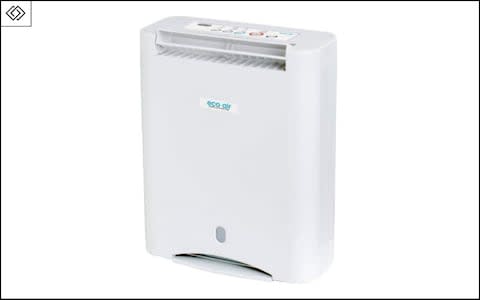
Desiccant dehumidifiers are said to work better in cooler conditions, so this might just be the trick for your dank, cold basement or attic. Houghton praises it for its "excellent water extraction at room temperature and below," and its several useful features, like a sizeable carry handle, a timer, a laundry mode and economy, high and auto settings.
To be sure, this isn't the largest dehumidifier around. The tank's capacity is only 3.5 litres; it won't be effective across the whole house like the Meaco above. Yet, for a small flat, or a basement or attic, it's more than enough.
It's incredibly easy to use, not particularly ugly (the bar is low in the dehumidifier world), relatively light and not too loud. If you're looking for something portable, this is your best bet.
3. Duronic DH05 mini dehumidifier
Why we like it: Best budget dehumidifier
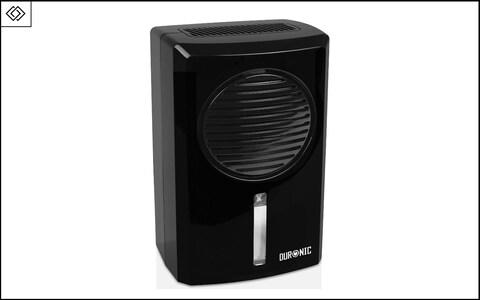
Not everyone can splash £300 on a dehumidifier; and frankly, in many cases, you don't need to. This is a compact, budget dehumidifier that's ideal for small, targeted areas that have been affected – a windowless bathroom, perhaps; or a cupboard where clothes might be damaged by moisture.
This isn't one for large, airy homes. The water tank is only 500ml, but that's more than enough for small rooms. The visible water compartment is useful, too, so you don't need to open it up to check the level. It also switches off automatically when full.
In essence, this does the basics well; it's remarkably quiet, and it's light and portable.
4. EcoAir DD1 MK5 classic desiccant dehumidifier
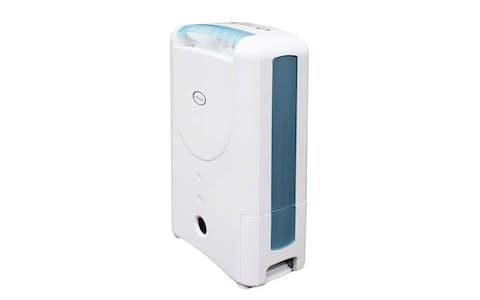
Stanley cites EcoAir as a top dehumidifier producer, and, for Houghton, this is one of the best desiccant devices around. Part of its appeal is in its compact design. Whereas many dehumidifiers are clunky, ungainly beasts, this one is streamlined – at just 29cm wide, with a depth of 17cm, you'll struggle to find anything smaller, save for a budget or mini dehumidifier.
But the size doesn't impact on performance; it still extracts water quickly, though the tank is only two litres (meaning you'll have to empty it more often). As a desiccant dehumidifier, combined with the size, this is ideal for smaller, colder spaces. An added ioniser and anti-bacterial filter will be a boost to allergy sufferers.
The EcoAir is up there with the most portable you'll find as it weighs just 6kg; it isn't too expensive; and according to Houghton it's "one of the quietest dehumidifiers we've seen." With added features like a laundry mode for drying clothes, tilt protection in case it's knocked over, and a timer, there's little not to like.
It's worth noting the dehumidifier has recently been renamed as the DD1 Classic Mk5, but you're more likely to see it listed as the DD122 FW online.
5. Ebac 3850e 21 litre refrigerant dehumidifier
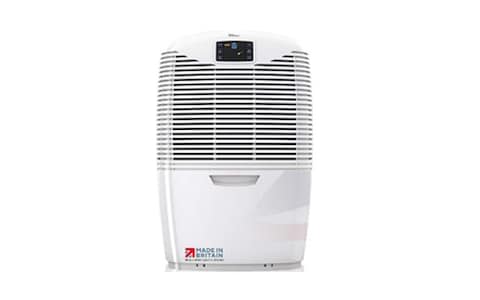
This dehumidifier can suck up 21 litres of moisture a day, which is a significant amount. It's one of the most powerful home-use dehumidifiers out there, so if you're in a particularly humid area, or want to dehumidify large spaces, this could be your best bet.
It's a fairly basic looking contraption from British brand Ebac. But looks can be deceiving, as the device is anything but. Its USP is the smart functionality – most significantly, this includes an auto function, that detects the surrounding environment and decides whether the machine needs to be on. This can save on electricity bills, as it won't be running when it doesn't need to be.
However, while it's full of bells and whistles, is powerful, and has a large water-extracting capacity, there are some minor negatives. Firstly, it's heavy, therefore not very portable at all. It's also quite loud, though there is a quiet mode (which naturally becomes less effective at extraction).
Nevertheless, it's a top dehumidifier by Ebac, which comes with the added bonus of an air purification function. It's also said to be better suited to the UK weather than many others, as it has an 'Intelligent Defrost' system which prevents the machine from freezing over in cold weather.
6. Pro Breeze 500ml compact and portable mini air dehumidifier
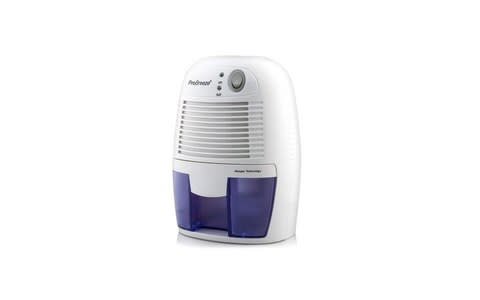
If you've only got small areas that need dehumidifying, such as a bathroom or kitchen, or even a cupboard or closet, then you don't need a chunky, powerful device. A compact, portable dehumidifier such as this model by Pro Breeze should do just fine.
The 500ml tank, the size of your average water bottle, means it will require regular emptying. On top of that, it's very quiet.
However, it uses peltier technology, which is different to desiccant or refrigerant dehumidifiers. Essentially, a temperature difference is created by electricity, and this encourages dehumidification. It's thought to be not quite as effective as the two main types of dehumidifier, but it's powerful enough for small rooms.


 Yahoo News
Yahoo News 
